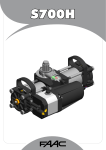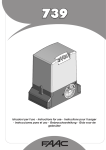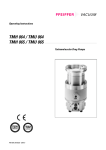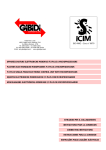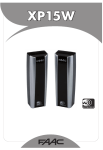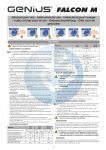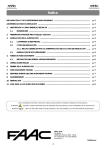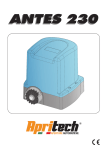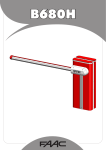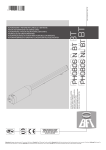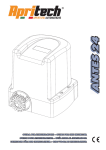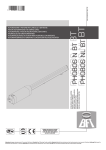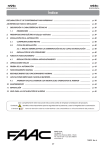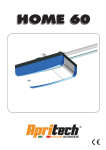Download Guida per l`utente Instructions pour l`utilisateur Anleitungen
Transcript
S800H Guida per l’utente User's guide Instructions pour l’utilisateur Anleitungen für den Benutzer Guía para el usuario Gebruikersgids AUTOMAZIONE S800H GUIDA PER L’UTENTE NORME GENERALI DI SICUREZZA L’automazione S800H, se correttamente installata ed utilizzata, garantisce un elevato grado di sicurezza. Alcune semplici norme di comportamento possono evitare inoltre inconvenienti accidentali: - Non transitare tra le ante quando queste sono in movimento. Prima di transitare tra le ante, attendere l’apertura completa. - Non sostare assolutamente tra le ante. - Non sostare e non permettere a bambini, persone o cose di sostare nelle vicinanze dell’automazione, evitandolo ancor più durante il funzionamento. - Tenere fuori dalla portata dei bambini, radiocomandi o qualsiasi altro datore d’impulso per evitare che l’automazione possa essere azionata involontariamente. - Non permettere ai bambini di giocare con l’automazione. - Non contrastare volontariamente il movimento delle ante. - Evitare che rami o arbusti possano interferire col movimento delle ante. - Mantenere efficienti e ben visibili i sistemi di segnalazione luminosa. - Non tentare di azionare manualmente le ante se non dopo averle sbloccate. - In caso di malfunzionamento, sbloccare le ante per consentire l’accesso ed attendere l’intervento tecnico di personale qualificato. - Una volta predisposto il funzionamento manuale, prima di ripristinare il funzionamento normale, togliere alimentazione elettrica all’impianto. - Non eseguire alcuna modifica sui componenti facenti parte del sistema d’automazione. - Astenersi da qualsiasi tentativo di riparazione o d’intervento diretto e rivolgersi solo a personale qualificato. - Far verificare almeno semestralmente l’efficienza dell’automazione e dei dispositivi di sicurezza da personale qualificato. DESCRIZIONE Le presenti istruzioni sono valide per i seguenti modelli: S800H SB - S800H CBAC L’automazione FAAC S800H per cancelli a battente è un monoblocco oleodinamico che, installato a scomparsa nel terreno, non altera l’estetica dell’anta. Il modello dotato di blocco idraulico non necessita di installare l’elettroserratura, garantendo il blocco meccanico dell’ anta quando il motore non è in funzione. Il modello senza blocco idraulico necessita sempre di una o più elettroserrature per garantire il blocco meccanico dell’anta. Le automazioni S800H sono state progettate e costruite per automatizzare cancelli a battente. Evitare qualsiasi altro diverso utilizzo. In relazione al modello prescelto si possono automatizzare ante fino a 4 mt e 800 kg. ll funzionamento degli operatori è gestito da una centralina elettronica di comando, racchiusa in un contenitore con adeguato grado di protezione agli agenti atmosferici. Le ante normalmente si trovano in posizione di chiusura. Quando la centralina elettronica riceve un comando di apertura tramite il radiocomando o qualsiasi altro datore di impulso, aziona l’apparato oleodinamico ottenendo la rotazione delle ante, fino alla posizione di apertura che consente l’accesso. Se è stato impostato il funzionamento automatico, le ante si richiudono da sole dopo il tempo di pausa selezionato. Se è stato impostato il funzionamento semiautomatico, è necessario inviare un secondo impulso per ottenere la richiusura. Un impulso di stop (se previsto) arresta sempre il movimento. Per il dettagliato comportamento dell’automazione nelle diverse logiche di funzionamento, fare riferimento al Tecnico installatore. Nelle automazioni sono presenti dispositivi di sicurezza di tipo D (fotocellule), che impediscono il movimento delle ante quando un ostacolo si trova nella zona da loro protetta. L’ automazione S800H dispone di serie di un dispositivo elettronico che, collegato ad una opportuna apparechiatura elettronica, rileva la presenza di un eventuale ostacolo, e provoca l’inversione di marcia della ante. La segnalazione luminosa indica il movimento in atto delle ante. FUNZIONAMENTO MANUALE AVVERTENZA: PRIMA DI EFFETTUARE LE OPERAZIONI DI SBLOCCO O BLOCCO ACCERTARSI DI AVERE TOLTO TENSIONE ALL’OPERATORE. SBLOCCO OLEODINAMICO DELL’OPERATORE Nel caso sia necessario azionare manualmente il cancello a causa di mancanza di corrente o disservizio dell’automazione, occorre agire sul dispositivo di sblocco oleodinamico: 1) Svitare il coperchio e rimuoverlo. 2) Agire sulla vite si sblocco (Fig.1 rif.a ), inserendovi lo scasso triangolare della chiave in dotazione (Fig.1 rif.b ): - Per sbloccare, ruotare la vite di sblocco in senso antiorario fino alla battuta meccanica. - Per ribloccare, ruotare la vite di sblocco in senso orario fino alla battuta meccanica. a b VITE DI SBLOCCO CHIAVE DI SBLOCCO Fig.1 CHIAVE DI SBLOCCO STAFFA DI SOSTEGNO Fig.1A LEVA DI SBLOCCO Fig.2 - Per sbloccare, inserire la chiave nella serratura, ruotare in senso antiorario fino a battuta meccanica. - Per ribloccare, inserire la chiave nella serratura, ruotare in senso orario fino a battuta. LEVA DI SBLOCCO a SBLOCCO DI EMERGENZA MECCANICO (OPTIONAL) Per l’operatore S800H è presente, come optional, uno sblocco manuale meccanico di emergenza. Nel caso sia necessario azionare manualmente il cancello a causa di mancanza di corrente o disservizio dell’automazione, occorre agire sul dispositivo di sblocco a chiave. Il dispositivo è inserito sulla staffa di sostegno del cancello e permette di sbloccare il sistema sia dall’interno che dall’esterno della proprietà. Per azionare manualmente l’anta agire come segue: b SPORTELLINO DI PROTEZIONE c CHIAVE DI SBLOCCO Fig.3 1) Aprire lo sportellino di protezione (Fig.3 rif. b ). 2) Introdurre la chiave di sblocco nella serratura (Fig.3 rif. c ) e ruotarla in senso orario fino alla battuta. 3) Tirare la leva di sblocco verso di sé (Fig.3 rif. a ). 4) Azionare manualmente l’anta. Per riportare il sistema al suo funzionamento normale (Cancello sbloccato), agire come di seguito: 1) Riportare la leva di sblocco nella sua posizione di riposo (Fig.2) 2) Introdurre la chiave di sblocco nella serratura e ruotarla in senso contrario fino alla battuta. 3) Azionare manualmente l’anta fino all’aggancio della serratura sulla staffa di bloccaggio. 4) Richiudere il tappo di protezione della serratura. MANUTENZIONE Fare effettuare semestralmente, da un tecnico qualificato, la verifica funzionale dell’impianto, con particolare attenzione all’efficienza dei dispositivi di sicurezza e di sblocco, ed alla perfetta funzionalità delle cerniere del cancello. Fare verificare inoltre la quantità dell’olio all’interno del serbatoio, eventuali rabbocchi devono essere effettuati solo con OLIO FAAC HP OIL. AUTOMATED SYSTEM S800H USER’S GUIDE GENERAL SAFETY REGULATIONS If correctly installed and used, the S800H automated system ensures a high degree of safety. Some simple rules on behaviour can prevent accidental trouble: - Do not pass between the leaves when they are moving. Wait for the leaves to open fully before passing through them. - Do not, on any account stay in between the leaves. Do not stand near the automated system, and do not allow children, persons or things to do so, especially when it is operating. - Keep radio controls or other pulse generators away from children, to prevent the automated system from being activated involuntarily. - Do not allow children to play with the automated system. - Do not willingly obstruct leaf movement. - Prevent any branches or shrubs from interfering with leaf movement. - Keep the indicator-lights efficient and easy to see. - Do not attempt to activate the leaves by hand unless you have released them. - In the event of malfunctions, release the leaves to allow access and wait for qualified technical personnel to do the necessary work. - When you have set manual operation mode, cut power to the system before restoring normal operation. - Do not in any way modify the components of the automated system. - Do not attempt any kind of repair or direct action whatever and contact qualified personnel only. - At least every 6 month: arrange for qualified personnel to check the efficiency of the automated system and the safety devices. DESCRIPTION These instructions apply to the following models: S800H SB - S800H CBAC The FAAC S800H automated system for swing leaf gates is a hydraulic enbloc which, when installed invisibly in the ground, does not alter the appearance of the leaf. The model with a hydraulic shut-down facility does not require installation of an electrical lock, as it guarantees mechanical shut-down of the leaf when the motor is not operating. The model without a hydraulic shut-down facility always requires one or more electrical locks to ensure the leaf is mechanically shut down. The S800H automated systems were designed and built to automate swing leaf gates. Do not use for any other purpose. Leaves of up to 4 mt and 800 Kg can be automated depending on the selected model. The functioning of the operators is controlled by an electronic control unit, housed in an enclosure with adequate degree of protection against atmosphere agents. The leaves are normally in closed position. When the control unit receives an opening command via the radio control or any other pulse generator, it activates the hydraulic appliance which rotates the leaves until they reach the opening position to allow access. If automatic mode was set, the leaves close automatically after selected pause time has elapsed. If the semi-automatic mode was set, a second pulse must be sent to close the leaf again. A stop pulse (if supplied) always stops movement. For details on the behaviour of the automated system in different function logics, consult the installation Technician. Automated systems include safety devices (photocells) that prevent the leaves from moving when there is an obstacle in the area they protect. The S800H automated system is supplied standard with an electronic device which, when connected to a suitable control unit, detects the presence of a possible obstacle, and reverses the movement of the leaf. The warning-light indicates the current leaf movement. MANUAL OPERATION WARNING: BEFORE CARRYING OUT THE RELEASE AND SHUT-DOWN OPERATIONS, MAKE SURE THAT YOU HAVE CUT POWER TO THE OPERATOR. HYDRAULIC RELEASE OF THE OPERATOR If the gate has to be moved manually due to a power cut or fault of the automated system, use the hydraulic release: 1) Unscrew the cover and remove it. 2) Turn the release screw (Fig.1 ref.a) inserting the triangular recess of the supplied key (Fig.1 ref.b): - To release, turn the release screw anti-clockwise up to the mechanical stop point. - To shut-down again, turn the release screw clockwise up to the mechanical stop point. a RELEASE SCREW b RELEASE KEY Fig.1 RELEASE KEY SUPPORT BRACKET Fig.1A RELEASE LEVER Fig.2 - To unlock, insert the key into the lock and turn clockwise until the mechanical stop. - To re-lock, insert the key into the lock and turn it clockwise until it stops. RELEASE LEVER a MECHANICAL EMERGENCY RELEASE (OPTIONAL) For the S800H operator, a manual mechanical emergency release is available as an optional item. If the gate has to be moved manually due to a power cut or fault of the automated system, use the release key device. The device is inserted on the gate support bracket and enables you to release the system from both inside and outside the premises. Procedure for manual leaf operation: 1) Open the protective hatch (Fig.3 ref.b). 2) Insert the release key in the lock (Fig.3 ref.c) and turn it clockwise sense up to its stop point. 3) Pull the release lever toward you (Fig.3 ref.a). 4) Move the leaf by hand. Procedure for restoring the system to normal operation (Gate released): 1) Move the release lever back to its rest position (Fig.2) 2) Insert the release key in the lock, turn it in the opposite direction up to the stop point. 3) Move the leaf manually until the lock hooks on the shut-down bracket. 4) Close the protective plug of the lock. b PROTECTIVE HATCH c RELEASE KEY Fig.3 MAINTENANCE Every 6 months, arrange for a qualified technician to run a functional check of the system, with special attention to the efficiency of the safety and release devices, and to perfect operation of the gate hinges. Also arrange a check of the quantity of oil inside the tank - for any topping up, strictly use OLIO FAAC HP OIL only. AUTOMATISME S800H INSTRUCTIONS POUR L’UTILISATEUR PRESCRIPTIONS GÉNÉRALES DE SÉCURITÉ S’il est correctement installé et utilisé, l’automatisme S800H garantit un haut niveau de sécurité. Par ailleurs, quelques règles simples de comportement peuvent éviter bien des accidents: - Ne pas transiter entre les vantaux en mouvement. Avant de transiter entre les vantaux, attendre l’ouverture complète. - Ne jamais stationner entre les vantaux. - Ne pas stationner et interdire aux enfants, aux personnes et aux choses de stationner près de l’automatisme et en particulier durant le fonctionnement. - Éloigner de la portée des enfants les radiocommandes ou tout autre dispositif générateur d’impulsion, pour éviter que l’automatisme ne soit actionné involontairement. - Interdire aux enfants de jouer avec l’automatisme. - Ne pas contraster volontairement le mouvement des vantaux. - Éviter que des branches ou des arbustes n’entravent le mouvement des vantaux. - Faire en sorte que les systèmes de signalisation lumineuse soient toujours efficients et bien visibles. - N’actionner manuellement les vantaux qu’après les avoir déverrouillés. - En cas de dysfonctionnement, débloquer les vantaux pour permettre l’accès et attendre l’intervention technique du personnel qualifié. - Lorsque le fonctionnement manuel a été prédisposé, couper le courant sur l’installation avant de rétablir le fonctionnement normal. - N’effectuer aucune modification sur les composants qui font partie du système d’automation. - Éviter toute tentative de réparation ou d’intervention et s’adresser uniquement au personnel qualifié. - Faire vérifier, au moins tous les six mois, l’efficience de l’automatisme et des dispositifs de sécurité par du personnel qualifié. DESCRIPTION Ces instructions sont valables pour les modèles suivants: S800H SB - S800H CBAC L’automatisme FAAC S800H pour portails battants est un monobloc hydraulique escamotable qui, installé dans le sol, n’altère pas l’esthétique du vantail. Le modèle équipé d’un blocage hydraulique n’exige pas d’électroserrure, garantissant le blocage mécanique du vantail, quand le moteur n’est pas en fonction. Le modèle sans blocage hydraulique exige toujours une ou plusieurs électroserrures pour garantir le blocage mécanique du vantail. Les automatismes S800H ont été conçus et construits pour automatiser des portails battants. Éviter toute autre utilisation. Suivant le modèle choisi, on peut automatiser des vantaux jusqu’à 4 m et 800 kg. Le fonctionnement des opérateurs est géré par une centrale électronique de manœuvre, à l’intérieur d’un boîtier au degré de protection adéquat contre les agents atmosphériques. Les vantaux se trouvent normalement en position de fermeture. Quand la centrale électronique reçoit une commande d’ouverture par l’intermédiaire de la radiocommande ou de tout autre générateur d’impulsions, elle actionne l’appareil hydraulique obtenant la rotation des vantaux, jusqu ’à la position d ’ouverture qui permet l ’accès. Si l’on a programmé le fonctionnement automatique, les vantaux se referment d’eux-mêmes après le temps de pause sélectionné. Si l’on a programmé le fonctionnement semi-automatique, envoyer une deuxième impulsion pour obtenir la refermeture. Une impulsion d’arrêt (si prévu) arrête toujours le mouvement. Pour le comportement détaillé de l’automatisme dans les différentes logiques de fonctionnement, consulter l’Installateur. Les automatismes sont munis de dispositifs de sécurité (photocellules) qui empêchent le mouvement des vantaux lorsqu’un obstacle se trouve dans la zone qu’ils protègent. L’automatisme S800H dispose en série d’un dispositif électronique qui, connecté à une armoire électronique opportune, détecte la présence d’un obstacle éventuel et provoque l’inversion de marche des vantaux. La signalisation lumineuse indique le mouvement en cours des vantaux. FONCTIONNEMENT MANUEL AVERTISSEMENT: AVANT D’EFFECTUER LES OPÉRATIONS DE DÉVERROUILLAGE OU DE BLOCAGE, S’ASSURER QUE L’OPÉRATEUR EST HORS TENSION. DÉVERROUILLAGE HYDRAULIQUE DE L’OPÉRATEUR S’il faut actionner manuellement le portail en raison d’une coupure de courant ou d’un dysfonctionnement de l’automatisme, agir sur le dispositif de déverrouillage hydraulique: 1) Dévisser le couvercle et l’enlever. 2) Agir sur la vis de déverrouillage (Fig.1 réf.a), en y introduisant le défoncement triangulaire de la clé fournie (Fig.1 réf.b): - Pour déverrouiller, tourner la vis en sens inverse horaire jusqu’à la butée mécanique. - Pour bloquer, tourner la vis en sens horaire jusqu’à la butée mécanique. a VIS DE DÉVERROUILLAGE b CLÉ DE DÉVERROUILLAGE Fig.1 CLÉ DE DÉVERROUILLAGE PATTE DE SUPPORT Fig.1A LEVIER DE DÉVERROUILLAGE Fig.2 - Pour le déverrouiller, insérez la clé dans la serrure et tournez dans le sens horaire jusqu’à la butée mécanique. - Pour re-verrouiller, insérez la clé dans la serrure et tournez-la jusqu’à ce qu’elle s’arrête. LEVIER DE DÉVERROUILLAGE a DÉVERROUILLAGE MÉCANIQUE D’URGENCE (OPTION) L’opérateur S800H est équipé, en option, d’un déverrouillage manuel mécanique d’urgence. Si nécessaire, actionner manuellement le portail; en cas de coupure de courant ou de dysfonctionnement de l’automatisme, agir sur le dispositif de déverrouillage à clé. Le dispositif est monté sur la patte de support du portail et permet de déverrouiller le système de l’intérieur et de l’extérieur de la propriété. Pour actionner manuellement le vantail, procéder comme suit: 1) Ouvrir le capot de protection (Fig.3 réf. b). 2) Introduire la clé de déverrouillage dans la serrure (Fig.3 réf. c) et la tourner jusqu’à la butée. 3) Tirer le levier de déverrouillage vers soi (Fig.3 réf. a). 4) Actionner manuellement le vantail. Pour ramener le système à son fonctionnement normal (Portail déverrouillé), procéder comme suit: 1) Ramener le levier de déverrouillage dans sa position de repos (Fig.2). 2) Introduire la clé de déverrouillage dans la serrure et la tourner dans le sens inverse jusqu’à la butée. 3) Actionner manuellement le vantail jusqu’à l’accrochage de la serrure à la patte de blocage. 4) Refermer le bouchon de protection de la serrure. b CAPOT DE PROTECTION c CLÉ DE DÉVERROUILLAGE Fig.3 ENTRETIEN Faire contrôler tous les six mois par un technicien qualifié le fonctionnement normal de l ’installation, en faisant particulièrement attention à l’efficience des dispositifs de sécurité et de déverrouillage et à la fonctionnalité parfaite des charnières du portail. Vérifier en outre la quantité d’huile à l’intérieur du réservoir. Si nécessaire, faire l’appoint uniquement avec de l’huile FAAC HP OIL. AUTOMATION S800H ANWEISUNGEN FÜR DEN BENUTZER ALLGEMEINE SICHERHEITSVORSCHRIFTEN Bei korrekter Installation und sachgemäßer Anwendung gewährleistet die Automation S800H ein hohes Sicherheitsniveau. Einige einfache Verhaltensregeln können außerdem ungewollte Störungen vermeiden: - Nicht zwischen den Flügeln durchgehen/durchfahren, wenn diese sich bewegen. Vor der Durchfahrt bzw. dem Durchgang durch die Flügel ist deren vollständige Öffnung abzuwarten. - Auf keinen Fall zwischen den Flügeln stehen bleiben. - Kinder, Personen oder Dinge dürfen sich niemals in der Nähe der Automation aufhalten, dies ist insbesondere während des Betriebs zu vermeiden. - Funksteuerungen oder andere Impulsgeber sind außerhalb der Reichweite von Kindern aufzubewahren, um zu vermeiden, dass die Automation ungewollt betätigt wird. - Kinder dürfen nicht mit der Automation spielen. - Die Bewegung der Flügel darf nicht absichtlich behindert werden. - Vermeiden, dass Zweige oder Büsche die Bewegung der Flügel beeinträchtigen. - Darauf achten, dass die Leuchtsignalsysteme stets funktionstüchtig und gut sichtbar sind. - Die Flügel dürfen nur dann mit der Hand betätigt werden, wenn sie entriegelt wurden. - Bei Betriebsstörungen die Flügel entriegeln, um den Zugang zu ermöglichen und technische Fachkräfte benachrichtigen. - Wenn der Handbetrieb eingestellt ist, muss vor der Wiederherstellung des Normalbetriebs die Stromzufuhr zur Anlage unterbrochen werden. - Keine Änderungen an den Bauteilen des Automationssystems vornehmen. - Keine Reparaturen oder direkten Arbeiten selbst ausführen und sich nur an Fachkräfte wenden. - Im Abstand von mindestens 6 Monaten die Funktionstüchtigkeit der Automation und der Sicherheitsvorrichtungen von Fachkräften überprüfen lassen. BESCHREIBUNG Diese Anleitungen beziehen sich auf folgende Modelle: S800H SB – S800H CBAC Die Automation FAAC S800H für Flügeltore ist aus einem ölhydraulischen Kompaktteil gebildet, das versenkt im Boden installiert ist und somit die Optik des Flügels nicht beeinträchtigt. Beim Modell mit hydraulischer Klemmung muss das Elektroschloss nicht eingebaut werden, da diese die mechanische Sperre des Flügels gewährleistet, wenn der Motor nicht läuft. Beim Modell ohne hydraulische Klemmung müssen stets eines oder mehrere Elektroschlösser eingebaut werden, um die mechanische Sperre des Flügels zu gewährleisten. Im Hinblick auf Planung und Bau wurden die Automationen S800H für die Automatisierung von Flügeltoren ausgelegt. Alle anderen Anwendungen sind zu vermeiden. Je nach gewähltem Modell können Flügel bis zu 4 m Länge und 800 kg Gewicht automatisiert werden. Der Betrieb der Antriebe wird von einem elektronischen Steuergerät gesteuert, das sich in einem Gehäuse mit entsprechender Schutzart gegen Witterungseinflüsse befindet. In der Regel sind die Flügel geschlossen. Wenn das elektronische Steuergerät einen Impuls zur Öffnung über Funksteuerung oder einen beliebigen anderen Impulsgeber empfängt, wird das ölhydraulische System in Betrieb gesetzt, das die Flügel so weit dreht und öffnet, bis der Durchgang möglich ist. Wenn der Automatikbetrieb eingestellt wurde, schließen sich die Flügel selbsttätig nach der angewählten Pausenzeit. Wenn die halbautomatische Funktionsweise eingestellt wurde, muss ein zweiter Impuls gesendet werden, damit die Flügel sich schließen. Ein Halteimpuls (wenn vorgesehen) stoppt stets die Bewegung. Für die detaillierte Betriebsweise der Automation mit den verschiedenen Steuerungslogiken wenden Sie sich bitte an den mit der Installation beauftragten Techniker. Die Automationen enthalten Sicherheitsvorrichtungen (Fotozellen), die die Bewegung der Flügel verhindern, wenn sich ein Hindernis im jeweiligen geschützten Bereich befindet. Die Automation S800H verfügt in der Standardausführung über eine elektronische Vorrichtung, die durch den Anschluss an ein entsprechendes elektronisches Steuergerät ein eventuelles Hindernis erfasst und die Bewegungsumkehrung des Flügels bewirkt. Das Leuchtsignal signalisiert die laufende Bewegung der Flügel. HANDBETRIEB HINWEIS: VOR DEM ENTRIEGELN ODER VERRIEGELN SICHERSTELLEN, DASS DIE SPANNUNGSZUFUHR ZUM ANTRIEB UNTERBROCHEN WURDE. HYDRAULISCHE ENTRIEGELUNG DES ANTRIEBS Sollte es aufgrund von Stromausfall oder Betriebsstörungen der Automation erforderlich sein, das Tor mit der Hand zu bewegen, ist die hydraulische Entriegelungsvorrichtung wie folgt zu betätigen: 1) Den Deckel abschrauben und entfernen. 2) Die dreieckige Nut des mitgelieferten Schlüssels (Abb.1, Bez.b) in die Entriegelungsschraube (Abb.1, Bez.a) einsetzen: - Zum Entriegeln die Schraube bis zum mechanischen Anschlag gegen den Uhrzeigersinn drehen. - Zum Verriegeln die Schraube bis zum mechanischen Anschlag im Uhrzeigersinn drehen. a ENTRIEGELUNGSSCHRAUBE b ENTRIEGELUNGSSCHLÜSSEL Abb.1 ENTRIEGELUNGSSCHLÜSSEL HALTEBÜGEL Abb.1A ENTRIEGELUNGSHEBEL Abb.2 - Um die Sperre aufzuheben, den Schlüssel in das Schloss und im Uhrzeigersinn bis zum mechanischen Anschlag. - Um wieder sperren, den Schlüssel in das Schloss und im Uhrzeigersinn drehen bis zum Anschlag. ENTRIEGELUNGSHEBEL a MECHANISCHE NOTENTRIEGELUNG (EXTRA) Als Extrazubehör ist für den Antrieb S800H eine manuelle mechanische Notentriegelung verfügbar. Sollte es aufgrund von Stromausfall oder Betriebsstörungen der Automation erforderlich sein, das Tor mit der Hand zu bewegen, ist die Entriegelungsvorrichtung mit Schlüssel einzusetzen. Die Vorrichtung befindet sich auf dem Haltebügel des Tors und ermöglicht die Entriegelung des Systems sowohl von innen als auch von außen. Zur manuellen Bewegung des Flügels sind folgende Schritte vorzunehmen: 1) Die Schutzklappe öffnen (Abb.3, Bez.b). 2) Den Entriegelungsschlüssel in das Schloss einführen (Abb. 3 Bez. c) und bis zum Anschlag drehen. 3) Den Entriegelungshebel an sich ziehen (Abb.3, Bez.a). 4) Den Flügel mit der Hand bewegen. Zur Wiederherstellung des Normalbetriebs des Systems (Tor entriegelt) sind die nachfolgenden Schritte auszuführen: 1) Den Entriegelungshebel in die Ruhestellung bringen (Abb.2) 2) Den Entriegelungsschlüssel in das Schloss einführen und in entgegengesetzter Richtung bis zum Anschlag drehen. 3) Den Flügel mit der Hand so weit schieben, bis das Schloss in den Sperrbügel eingreift. 4) Die Schutzabdeckung des Schlosses erneut verschließen. b SCHUTZKLAPPE c ENTRIEGELUNGSSCHLÜSSEL Abb.3 WARTUNG Im Abstand von 6 Monaten die Funktionsprüfung der Anlage durch einen qualifizierten Techniker vornehmen und dabei besonders auf die Funktionstüchtigkeit der Sicherheits- und Entriegelungsvorrichtungen sowie die einwandfreie Funktionstüchtigkeit der Scharniere des Tors achten. Außerdem den Ölstand im Ölbehälter prüfen lassen. Zum Auffüllen nur FAAC HP OIL verwenden. AUTOMACIÓN S800H GUÍA PARA EL USUARIO NORMAS GENERALES DE SEGURIDAD La automación S800H, si se instala y utiliza correctamente, garantiza un elevado grado de seguridad. Algunas simples normas de comportamiento pueden evitar inconvenientes o accidentes: - No transite entre las hojas cuando las mismas están en movimiento. Antes de transitar entre las hojas espere su completa apertura. - No se detenga absolutamente entre las hojas. - No se detenga y no permita que niños, personas u objetos estén detenidos cerca de la automación, evitándolo todavía más durante el funcionamiento. - Mantenga fuera del alcance de los niños radiomandos o cualquier otro generador de impulsos para evitar que la automación pueda accionarse involuntariamente. - No permita que los niños jueguen con la automación. - No obstaculice voluntariamente el movimiento de las hojas. - Evite que ramas o arbustos interfieran con el movimiento de las hojas. - Mantenga en buen estado y bien visibles los sistemas de señalización luminosa. - No intente accionar manualmente las hojas si no están desbloqueadas. - En caso de mal funcionamiento, desbloquee las hojas para permitir el acceso y espere a que personal técnico cualificado intervenga para solucionar el problema. - Una vez preparado el funcionamiento manual, quite la alimentación eléctrica al equipo antes de reanudar el funcionamiento normal. - No efectúe ninguna modificación en los componentes que formen parte del sistema de automación. - Absténgase de intentar reparar o de intervenir directamente, diríjase exclusivamente a personal cualificado. - Haga verificar por lo menos semestralmente el buen funcionamiento de la automación y de los dispositivos de seguridad por personal cualificado. DESCRIPCIÓN Las presentes instrucciones son válidas para los siguientes modelos: S800H SB - S800H CBAC La automación FAAC S800H para cancelas batientes es un monobloque oleodinámico que se instala soterrado en el terreno, por lo que no altera la estética de la hoja. El modelo está provisto de bloqueo hidráulico y no requiere la instalación de la electrocerradura, garantizando el bloqueo mecánico de la hoja incluso cuando el motor no está en funcionamiento. El modelo sin bloqueo hidráulico necesita siempre una o varias electrocerraduras para garantizar el bloqueo mecánico de la hoja. Las automaciones S800H han sido proyectadas y fabricadas para automatizar cancelas batientes. Evítese cualquier otro uso. En función del modelo elegido se pueden automatizar hojas de hasta 4 mt y 800 kg de peso. El funcionamiento de los operadores está gestionado por una centralita electrónica de mando, ubicada en un contenedor con un adecuado grado de protección a los agentes atmosféricos. Las hojas normalmente están en posición de cierre. Cuando la centralita electrónica recibe un mando de apertura mediante el radiomando o cualquier otro generador de impulso, acciona el aparato oleodinámico obteniendo así la rotación de las hojas, hasta la posición de apertura que permite el acceso. Si se ha programado el funcionamiento automático, las hojas se cierran solas transcurrido el tiempo de pausa seleccionado. Si se ha programado el funcionamiento semiautomático, es necesario enviar un segundo impulso para obtener el cierre. Un impulso de stop (si estuviera previsto) detiene siempre el movimiento. Para conocer en detalle el comportamiento de la automación en las diferentes lógicas de funcionamiento, consulte al Técnico instalador. Las automaciones están equipadas con dispositivos de seguridad (fotocélulas) que impiden el movimiento de las hojas cuando un obstáculo se encuentra en la zona protegida por dichos dispositivos. La automación S800H dispone de serie de un dispositivo electrónico que, conectado a un oportuno equipo electrónico, detecta la presencia de un posible obstáculo e invierte la marcha de las hojas. La señalización luminosa indica el movimiento en acto de las hojas. FUNCIONAMIENTO MANUAL ADVERTENCIA: ANTES DE REALIZAR LAS OPERACIONES DE DESBLOQUEO O DE BLOQUEO, ASEGÚRESE DE QUE SE HA QUITADO LA TENSIÓN AL OPERADOR. DESBLOQUEO OLEODINÁMICO DEL OPERADOR Si fuera necesario mover la cancela manualmente, por ejemplo por un corte de corriente o un fallo de la automación, es necesario manipular el dispositivo de desbloqueo oleodinámico: 1) Destornille la tapa y retírela. 2) Manipule el tornillo de desbloqueo (Fig.1 ref.a), introduciendo en el mismo la ranura triangular de la llave suministrada en dotación (Fig.1 ref.b): - Para desbloquear, gire la llave en sentido antihorario hasta llegar al tope mecánico. - Para volver a bloquear, gire la llave en sentido horario hasta llegar al tope mecánico. a b TORNILLO DE DESBLOQUEO LLAVE DE DESBLOQUEO Fig.1 LLAVE DE DESBLOQUEO BRIDA DE SOPORTE Fig.1A PALANCA DE DESBLOQUEO Fig.2 - Para desbloquear, insertar la llave en la cerradura y gire hacia la derecha hasta el tope mecánico. - Para volver a bloquear, introducir la llave en la cerradura y gire en sentido horario hasta que se detenga. PALANCA DE DESBLOQUEO a DESBLOQUEO DE EMERGENCIA MECÁNICO (OPCIONAL) El operador S800H dispone, como opcional, de un desbloqueo manual mecánico de emergencia. Si fuera necesario mover la cancela manualmente, por ejemplo por un corte de corriente o un fallo de la automación, es necesario manipular el dispositivo de desbloqueo con llave. El dispositivo está situado en la brida de soporte de la cancela y permite desbloquear el sistema tanto desde el interior como desde el exterior de la propiedad. Para accionar manualmente la hoja proceda del siguiente modo: 1) Abra la portezuela de protección (Fig.3 ref. b). 2) Introduzca la llave de desbloqueo en la cerradura (Fig. 3 ref. c) y gírela en sentido horario hasta el tope. 3) Tire de la palanca de desbloqueo hacia sí mismo (Fig.3 ref. a). 4) Accione manualmente la hoja. Para restablecer el funcionamiento normal del sistema (Cancela desbloqueada), proceda del siguiente modo: 1) Coloque la palanca de desbloqueo en posición de reposo (Fig.2) 2) Introduzca la llave de desbloqueo en la cerradura y gírela en sentido contrario hasta el tope. 3) Accione manualmente la hoja hasta que la cerradura se enganche a la brida de bloqueo. 4) Cierre el tapón de protección de la cerradura. b PORTEZUELA DE PROTECCIÓN c LLAVE DE DESBLOQUEO Fig.3 MANTENIMIENTO Encargue a un técnico cualificado que compruebe semestralmente que el equipo funcione correctamente, prestando especial atención al funcionamiento de los dispositivos de seguridad y de desbloqueo, y que las bisagras de la cancela funcionen perfectamente. También deberá comprobarse la cantidad de aceite en el depósito, para reponer el nivel debe usarse exclusivamente ACEITE FAAC HP OIL. AUTOMATISCHE SYSTEEM S800H GEBRUIKERSGIDS ALGEMENE VEILIGHEIDSVOORSCHRIFTEN Het automatische systeem S800H garandeert, als het op correcte wijze is geïnstalleerd en gebruikt, een hoge mate van veiligheid. Daarnaast kunnen een aantal simpele gedragsregels accidentele ongemakken voorkomen: - Ga niet door de poort als de vleugels in beweging zijn. Wacht tot de vleugels helemaal geopend zijn alvorens door de poort te gaan. - Blijf absoluut niet tussen de vleugels staan. - Blijf niet in de buurt van het automatische systeem staan, en sta niet toe dat kinderen, personen of voorwerpen er in de buurt staan, en blijf nog verder uit de buurt als hij in werking is. - Houd de radio-afstandsbediening en alle andere impulsgevers buiten het bereik van kinderen, om te voorkomen dat het automatische systeem per ongeluk wordt ingeschakeld. - Sta niet toe dat kinderen met het automatische systeem spelen. - Houd niet opzettelijk de beweging van de vleugels tegen. - Zorg dat takken of struiken de beweging van de vleugels niet kunnen hinderen. - Zorg dat de lichtsignalen altijd goed werken en goed zichtbaar zijn. - Probeer de vleugels niet met de hand te bewegen als ze niet eerst ontgrendeld zijn. - In geval van storing moeten de vleugels worden ontgrendeld om toegang mogelijk te maken, en wacht op de technische assistentie van een gekwalificeerd technicus. - Als de handbediende werking is ingesteld, moet de elektrische voeding naar de installatie worden uitgeschakeld alvorens de normale werking te hervatten. - Voer geen wijzigingen uit op onderdelen die deel uitmaken van het automatische systeem. - Doe geen pogingen tot reparaties of directe ingrepen, en wend u uitsluitend tot gekwalificeerd personeel. - Laat de werking van het automatische systeem en de veiligheidsvoorzieningen minstens eenmaal per half jaar controleren door deskundig personeel. BESCHRIJVING Deze instructies gelden voor volgende modellen: S800H SB - S800H CBAC Het automatische systeem FAAC S800H voor vleugelpoorten is een hydraulisch monoblok dat, omdat hij onder de grond is geïnstalleerd, de vleugel niet ontsiert. Op modellen met een hydraulisch monoblok hoeft geen elektrische vergrendeling te worden gemonteerd, aangezien het monoblok een mechanische vergrendeling van de vleugel garandeert wanneer de motor niet in werking is. Bij het model zonder hydraulische vergrendeling moeten er altijd een of meerdere elektrische vergrendelingen worden gemonteerd om de mechanische vergrendeling van de deur te garanderen. De automatische systemen S800H zijn ontworpen en gebouwd om vleugelpoorten te automatiseren. Vermijd ieder ander gebruik. Van het gekozen model kunnen vleugels worden geautomatiseerd tot 4 meter en 800 kg. De werking van de aandrijvingen wordt bestuurd door een elektronische besturingseenheid die in een houder met een goede beschermingsgraad tegen weersinvloeden is geplaatst. De vleugels staan normaal gesproken in de gesloten stand. Wanneer de elektronische besturingseenheid een commando tot opening ontvangt via de radio-afstandsbediening of een andere impulsgever, schakelt hij het hydraulische apparaat in, waardoor de poort wordt gedraaid tot hij helemaal open is en toegang mogelijk is. Als de automatische werking is ingesteld, sluiten de vleugels vervolgens uit zichzelf na de ingestelde pauzetijd. Als de halfautomatische werking is ingesteld, moet een tweede impuls worden gegeven om de poort weer te sluiten. Een stop-impuls (indien voorzien) zorgt er altijd voor dat de beweging wordt gestopt. Raadpleeg een installatietechnicus voor het gedetailleerde gedrag van het automatische systeem met de verschillende bedrijfslogica’s. Automatische systemen hebben veiligheidsvoorzieningen (fotocellen) die de beweging van de vleugels verhinderen wanneer er zich een obstakel in het door hen beveiligde gebied bevindt. Het automatisch systeem S800H beschikt standaard over elektronische inrichting die, als hij op geschikte apparatuur wordt aangesloten, de aanwezigheid van een eventueel obstakel waarneemt, en de beweging van de vleugel omdraait. Het lichtsignaal geeft aan dat de vleugels in beweging zijn. HANDBEDIENDE WERKING WA ARSCHUWINGEN: CONTROLEER ALVORENS TE VERGRENDELEN OF TE ONTGRENDELEN OF DE SPANNING NAAR DE AANDRIJVING IS UITGESCHAKELD. ONTGRENDELING HYDRAULISCH SYSTEEM VAN DE AANDRIJVING Als de poort met de hand moet worden bediend omdat de stroom is uitgevallen of omdat het automatische systeem niet goed werkt, dient het hydraulische ontgrendelmechanisme te worden gebruikt: 1) Draai de dekplaat los en verwijder hem. 2) Draai aan de ontgrendelschroef (Fig.1 ref.a) met de bijgeleverde driekantsleutel (Fig.1 ref.b): - Om hem te ontgrendelen moet de ontgrendelschroef tegen de wijzers van de klok in worden gedraaid tot aan de mechanische aanslag. - Om hem te weer te vergrendelen moet de ontgrendelschroef met de wijzers van de klok mee worden gedraaid tot aan de mechanische aanslag. a b ONTGRENDELSCHROEF ONTGRENDELSLEUTEL Fig.1 ONTGRENDELSLEUTEL BEVESTIGINGSBEUGEL Fig.1A ONTGRENDELINGSHENDEL Fig.2 - Om te ontgrendelen, steek de sleutel in het slot en rechtsom draaien tot de mechanische stop. - Om opnieuw te vergrendelen, steek de sleutel in het slot en draai met de klok mee totdat hij stopt. ONTGRENDELINGSHENDEL a MECHANISCHE ONTGRENDELING VOOR NOODGEVALLEN (OPTIONEEL) De aandrijving S800H heeft, optioneel, een mechanische handmatige ontgrendeling voor noodgevallen. Als de poort met de hand moet worden bediend omdat de stroom is uitgevallen of omdat het automatische systeem niet goed werkt, dient het ontgrendelmechanisme met een sleutel te worden gebruikt. Het mechanisme zit op de bevestigingsbeugel van de poort en maakt het mogelijk het systeem zowel van binnen als van buitenaf te ontgrendelen. Handel als volgt om de vleugel met de hand te bedienen: 1) Open het beschermingsklepje (Fig.3 ref.b). 2) Steek de ontgrendelsleutel in het slot (Fig.3 ref. c) en draai hem tot hij niet verder kan. 3) Trek de ontgrendelingshendel naar u toe (Fig.3 ref.a). 4) Beweeg de vleugel met de hand. Handel als volgt om de normale werking van het systeem (Poort vergrendeld) te hervatten: 1) Zet de ontgrendelingshendel weer in de ruststand (Fig.2) 2) Steek de ontgrendelsleutel in het slot en draai hem in de tegengestelde richting tot hij niet verder kan. 3) Beweeg de poort met de hand tot de vergrendeling hij in de vergrendelingsbeugel haakt. 4) Sluit de beschermingsdop van de vergrendeling. b BESCHERMINGSKLEPJE c ONTGRENDELSLEUTEL Fig.3 ONDERHOUD Laat minstens ieder half jaar door een gekwalificeerd technicus controleren of de installatie goed werkt, en let daarbij met name op de goede werking van de veiligheids- en ontgrendelingsvoorzieningen, en die van de scharnieren van de poort. Laat tevens de kwaliteit van de olie in het reservoir controleren, als eventueel olie moet worden bijgevuld mag uitsluitend FAAC HP OIL worden gebruikt. SERIENUMMER Aanduiding van de restrisico’s en van voorzienbaar oneigenlijk gebruik Signaallamp Afstandsbediening Bedieningsvoorziening 2 Bedieningsvoorziening 1 Paar fotocellen 2 Paar fotocellen 1 Veiligheidsvoorziening 2 MODEL Configuratie installatie Veiligheidsvoorziening 1 Aandrijving ONDERDEEL Activering Datum installatie Serienummer Type installatie Klant Installateur Gegevens installatie 10 9 8 7 6 5 4 3 2 1 Nr. Datum ONDERHOUDREGISTER REGISTRO DI MANUTENZIONE Beschrijving ingreep Klant Technicus Klant Technicus Klant Technicus Klant Technicus Klant Technicus Klant Technicus Klant Technicus Klant Technicus Klant Technicus Klant Technicus Handtekeningen N° DE SERIE Indicación de los riesgos residuos y del uso impropio previsible Destellador Radiomando Dispositivo de mando 2 Dispositivo de mando 1 Par de fotocélulas 2 Par de fotocélulas 1 Dispositivo de seguridad 2 Dispositivo de seguridad 1 Operador MODELO Configuración del equipo COMPONENTE Activación Fecha de instalación N° de serie Tipo de equipo Cliente Instalador Datos equipo 10 9 8 7 6 5 4 3 2 1 N° Fecha Descripción de la intervención REGISTRO REGISTRODE DI MANTENIMIENTO MANUTENZIONE Cliente Técnico Cliente Técnico Cliente Técnico Cliente Técnico Cliente Técnico Cliente Técnico Cliente Técnico Cliente Técnico Cliente Técnico Cliente Técnico Firma SERIENNUMMER Angabe der Restrisiken und der voraussehbaren unsachgemäßen Anwendung Blinkleuchte Funksteuerung Schaltvorrichtung 2 Schaltvorrichtung 1 Fotozellenpaar 2 Fotozellenpaar 1 Sicherheitsvorrichtung 2 MODELL Konfiguration der Anlage Sicherheitsvorrichtung 1 Antrieb BAUTEIL Inbetriebnahme Installationsdatum Seriennummer Art der Anlage Kunde Monteur Daten der Anlage 10 9 8 7 6 5 4 3 2 1 Nr. Datum Beschreibung der Arbeiten WARTUNGSPROGRAMM REGISTRO DI MANUTENZIONE Kunde Techniker Kunde Techniker Kunde Techniker Kunde Techniker Kunde Techniker Kunde Techniker Kunde Techniker Kunde Techniker Kunde Techniker Kunde Techniker Unterschrift N° DE SERIE Indication des risques résiduels et de l’usage impropre prévisible Lampe clignotante Radiocommande Dispositif de commande 2 Dispositif de commande 1 Paire de photocellules 2 Paire de photocellules 1 Dispositif de sécurité 2 Dispositif de sécurité 1 Opérateur MODÈLE Configuration de l’installation COMPOSANT Activation Date d’installation N° de série Type d’installation Client Installateur Données de l’installation 10 9 8 7 6 5 4 3 2 1 N° Date Description de l’intervention REGISTRE D’ENTRETIEN REGISTRO DI MANUTENZIONE Client Technicien Client Technicien Client Technicien Client Technicien Client Technicien Client Technicien Client Technicien Client Technicien Client Technicien Client Technicien Signatures SERIAL NUMBER Indication of residual risks and of foreseeable improper use Flashing lamp Radio control Control device 2 Control device 1 Pair of photocells 2 MODEL System configuration Pair of photocells 1 Safety device 2 Safety device 1 Operator PART Start-up Installation date Serial No. Type of system Customer Installer System data 10 9 8 7 6 5 4 3 2 1 No. Date MAINTENANCE REGISTER REGISTRO DI MANUTENZIONE Job description Customer Technician Customer Technician Customer Technician Customer Technician Customer Technician Customer Technician Customer Technician Customer Technician Customer Technician Customer Technician Signatures Operatore MATRICOLA Indicazione dei rischi residui e dell’uso improprio prevedibile Lampeggiante Radiocomando Dispositivo di comando 2 Dispositivo di comando 1 Coppia fotocellule 2 Coppia fotocellule 1 Dispositivo di sicurezza 2 Dispositivo di sicurezza 1 MODELLO Configurazione impianto COMPONENTE Attivazione Data installazione Matricola Tipo impianto Cliente Installatore Dati impianto 10 9 8 7 6 5 4 3 2 1 Nr Data REGISTRO DI MANUTENZIONE Descrizione intervento Cliente Tecnico Cliente Tecnico Cliente Tecnico Cliente Tecnico Cliente Tecnico Cliente Tecnico Cliente Tecnico Cliente Tecnico Cliente Tecnico Cliente Tecnico Firme Le descrizioni e le illustrazioni del presente manuale non sono impegnative. La FAAC si riserva il diritto, lasciando inalterate le caratteristiche essenziali dell’apparecchiatura, di apportare in qualunque momento e senza impegnarsi ad aggiornare la presente pubblicazione, le modifiche che essa ritiene convenienti per miglioramenti tecnici o per qualsiasi altra esigenza di carattere costruttivo o commerciale. The descriptions and illustrations contained in the present manual are not binding. FAAC reserves the right, whilst leaving the main features of the equipments unaltered, to undertake any modifications it holds necessary for either technical or commercial reasons, at any time and without revising the present publication. Les descriptions et les illustrations du présent manuel sont fournies à titre indicatif. FAAC se réserve le droit d’apporter à tout moment les modifications qu’elle jugera utiles sur ce produit tout en conservant les caractéristiques essentielles, sans devoir pour autant mettre à jour cette publication. Die Beschreibungen und Abbildungen in vorliegendem Handbuch sind unverbindlich. FAAC behält sich das Recht vor, ohne die wesentlichen Eigenschaften dieses Gerätes zu verändern und ohne Verbindlichkeiten in Bezug auf die Neufassung der vorliegenden Anleitungen, technisch bzw. konstruktiv/kommerziell bedingte Verbesserungen vorzunehmen. Las descripciones y las ilustraciones de este manual no comportan compromiso alguno. FAAC se reserva el derecho, dejando inmutadas las características esenciales de los aparatos, de aportar, en cualquier momento y sin comprometerse a poner al día la presente publicación, todas las modificaciones que considere oportunas para el perfeccionamiento técnico o para cualquier otro tipo de exigencia de carácter constructivo o comercial. De beschrijvingen in deze handleiding zijn niet bindend. FAAC behoudt zich het recht voor op elk willekeurig moment de veranderingen aan te brengen die het bedrijf nuttig acht met het oog op technische verbeteringen of alle mogelijke andere productie- of commerciële eisen, waarbij de fundamentele eigenschappen van de apparaat gehandhaafd blijven, zonder zich daardoor te verplichten deze publicatie bij te werken. FAAC S.p.A. Via Calari, 10 40069 Zola Predosa (BO) - ITALIA Tel. 0039.051.61724 - Fax. 0039.051.758518 www.faac.it www.faacgroup.com 732706 - Rev.B




















